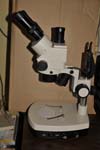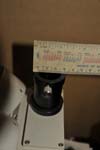

I have a Variscope Series 824 Trinocular Stereo Zoom Microscope. I am failing to achieve reasonable picture quality from the DSLR attachments sold to me as the correct products for this purpose. In this status this project remained from November 2008 until January 2012. The scope is great as a regular microscope but it was (and still is) non-functional as a photographic tool. In January of 2012, I am trying again...
The
microscope even though a relatively inexpensive model, it does provide crystal
clear
normal eyepiece viewing. When viewing by eye through the
trinocular port,
using the 1X C-Mount adapter tube, the silver adapter tube and the
photoeyepiece, the image is also crystal clear (to the eye).
When
placing my DSLR, a Nikon D300, on the trinocular port with the 1X
C-Mount
adapter tube, the
silver adapter tube,
the photoeyepiece, the T-Mount adapter and the appropriate T-Mount ring
for
Nikon cameras...
There are two points where optical path length adjustment is
possible:
Below the photoeyepiece (between the
microscope optics and the
photoeyepiece)
Above the photoeyepiece (between the
photoeyepiece and the camera
sensor)
When
changing the optical length above the photoeyepiece, it seems that the
magnification is changed and little or no focus correction occurs.
When changing the optical
length below the photoeyepiece, the focus
adjustment occurs
and little or no magnification change occurs.
At
no point of adjustment of these two optical lengths is it possible to
achieve true,
crisp image focus. It is possible to achieve a focus that is somewhat
close to
correct but it is NOT a crisp, clear image. To clarify, with this
configuration, the photoeyepiece is projecting the image directly onto
the
camera sensor.
Alternately,
I have tried inserting a Nikon lens in the path to insure a valid image
on the camera
sensor. For this, I used a Nikkor 60mm micro lens. I have an old Nikon
‘E’ adapter
that has an internal 42mm female thread that provides an adapter from
42mm
female thread to Nikon female Nikon lens mount. I have an old BR2
adapter ring that
has a Nikon male camera mount to a 52mm male thread. Next is a 52mm
female thread
to 62mm male thread adapter ring that finally screws into the 62mm
female filter
threads on the 60mm micro lens. (The internal 42mm female thread on the
‘E’
adapter is presumably a 1mm pitch. The external 42mm male thread on the
T-Mount
tube is .75mm pitch. The pitch of these two pieces is different but I
am able
to screw them together about 1 ½ turns to provide a good physical
connection
without damaging the threads.)
This
assembly goes above the trinocular port, 1X C-Mount adapter tube,
silver tube,
photoeyepiece assembly. The same two optical path length
adjustments are available. While this seems promising, I am able to
adjust it to
‘approaching’
correct focus but I run out of adjustment travel before achieving true
focus.
The assembly seems just a wee bit too long. I am thinking that the
length of
the ‘E’ plus BR2 ring is about ¾” and from hand holding the pieces in
position,
it seems that I need to get about 3/8” closer. I am planning to get a
42mm
female T-Mount thread to 52mm male filter thread adapter to replace the
‘E’/BR2
pair to test this idea. This should shorten the assembly by more than
½” and
reduce the overall assembly minimum length to less than what hand
holding seems
to indicate is the proper length. After about 2 hours of Internet
searching, it
seems that I can only find this adapter in England or Australia, not in
the US.
Many web sites fail to provide specifications for their adapter ring
products
so it is impossible to tell if what they are selling is what I am
trying to
find. Alternately, I could cut one of the tubes to make the path
shorter. I will order and await the adapter from England. I prefer to
not cut any pieces as I am really just guessing at what needs to be
done.
I
am frustrated that I purchased products that were supposed to provide
the
proper interface between the trinocular microscope port and a DSLR
camera. When
I test the products, it does provide an adequate physically interface
but there
is something very wrong with the optical interface. This optical
interface will
only produce low quality images. Both the microscope and the camera are
capable
of much better image quality.
(I
am also a little uncomfortable with the not sealed adapter tube
connections that
fail to provide complete dust protection to the camera's sensor cavity.
I am
inclined to instead use the Nikkor 60mm micro lens and have a better
dust seal for the high quality image solution.)